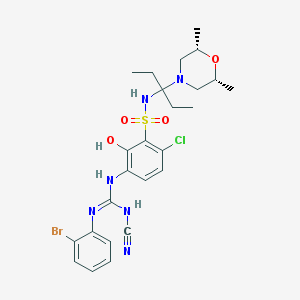

You can:
| Name | CHEMBL218486 |
|---|---|
| Molecular formula | C25H32BrClN6O4S |
| IUPAC name | 2-(2-bromophenyl)-1-[4-chloro-3-[3-[(2R,6S)-2,6-dimethylmorpholin-4-yl]pentan-3-ylsulfamoyl]-2-hydroxyphenyl]-3-cyanoguanidine |
| Molecular weight | 627.983 |
| Hydrogen bond acceptor | 8 |
| Hydrogen bond donor | 4 |
| XlogP | 6.1 |
| Synonyms | BDBM50193978 3-(2-bromophenyl)-1-[4-chloro-3-({3-[(2R,6S)-2,6-dimethylmorpholin-4-yl]pentan-3-yl}sulfamoyl)-2-hydroxyphenyl]-2-cyanoguanidine |
| Inchi Key | DNQSYCVLRVJIIH-CALCHBBNSA-N |
| Inchi ID | InChI=1S/C25H32BrClN6O4S/c1-5-25(6-2,33-13-16(3)37-17(4)14-33)32-38(35,36)23-19(27)11-12-21(22(23)34)31-24(29-15-28)30-20-10-8-7-9-18(20)26/h7-12,16-17,32,34H,5-6,13-14H2,1-4H3,(H2,29,30,31)/t16-,17+ |
| PubChem CID | 44419473 |
| ChEMBL | CHEMBL218486 |
| IUPHAR | N/A |
| BindingDB | 50193978 |
| DrugBank | N/A |
Structure |  |
| Lipinski's druglikeness | This ligand is heavier than 500 daltons. This ligand has a partition coefficient log P greater than 5. |
You can:
| GLASS ID | Name | UniProt | Gene | Species | Length |
|---|---|---|---|---|---|
| 64591 | C-X-C chemokine receptor type 1 | P25024 | CXCR1 | Homo sapiens (Human) | 350 |
| 64592 | C-X-C chemokine receptor type 2 | P25025 | CXCR2 | Homo sapiens (Human) | 360 |
zhanglab![]() zhanggroup.org | +65-6601-1241 | Computing 1, 13 Computing Drive, Singapore 117417
zhanggroup.org | +65-6601-1241 | Computing 1, 13 Computing Drive, Singapore 117417